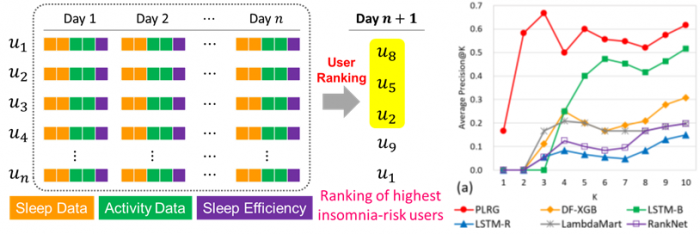
Directions
수면의 질을 예측하는 인공지능 알고리즘 개발
2020-10-05 11:04:53
KAIST 전산학부 차미영 교수 연구진이 웨어러블 기기 데이터를 기반으로 불면증 환자의 수면의 질과 환자들 간 불면증상 순위를 예측할 수 있는 해석 가능한 딥러닝 알고리즘을 개발했다.
수면의 질은 하루의 컨디션을 결정하는 중요한 요소이다. 특히 불면증(insomnia)은 미국 질병관리본부에서 공공보건의 유행병(epidemic)이라고 선포할 정도로 중요한 사회문제로, 다양한 질병과의 연관은 물론 국가적 차원에서 노동력의 산실을 가져올 수 있다. 불면증을 비롯한 다양한 질환에 대한 빅데이터 기반의 세밀한 모형화 연구는 최근 정밀정신건강의학(Precision Psychiatry)이라는 분야로 시작되고 있으며, 이에서는 정밀의학(precision medicine)과 마찬가지로 다양한 정신장애에 대한 중재(intervention) 혹은 치료법(therapy)을 제시할 때 개인의 다양한 특성을 고려할 수 있어 개인에게 맞춤화된 서비스를 제공하는 혁신을 가져오고 있다.
KAIST 전산학부 데이터 사이언스 연구실(지도: 차미영 교수)은 빅데이터 관점에서 수면 패턴과 개인의 행동 데이터를 웨어러블 디바이스에서 수집 및 분석함으로써 수면의 질을 예측하는 연구를 수행했다. 이 연구는 전산학 및 정신건강의학과 연구진과의 협업으로 진행되었으며 연구 결과는 데이터 마이닝 분야 최상위 학술대회인 ACM SIGKDD Conference on Knowledge Discovery and Data Mining (제목: Learning Sleep Quality from Daily Logs, KDD 2019) 및 디지털 헬스 분야의 저명 학회지인 JMIR mHealth and uHealth (제목: Clustering Insomnia Patterns by Data from Wearable Devices: Algorithm Development and Validation, JMU 2019, Impact Factor 4.541))에 게재되었다.
먼저 이 연구에서는 웨어러블 기기 데이터를 기반으로 불면증 환자들 수면의 질을 예측하는 해석 가능한 딥러닝 모델의 제시이다. 수면의 질은 다양한 방법으로 측정 가능한데 그 중 연구에서는 수면 효율(실제 잠든 시간/침대에 누운 총 시간)을 활용한다. 연구진은 42명의 피실험자를 대상으로 6주간 24시간 연속해서 행동 및 수면 데이터를 수집하였고, 이를 일별 벡터 형으로 만든 다음 해당 벡터를 연속적으로 LSTM-Attention ensemble 딥러닝 모델(그림 1.)에 주입하여 일별 수면 효율 지수를 예측하였다. 이 모델은 기존 방법 대비 예측 에러율이 9-16% 감소하며, 사용자별로 미래 수면 효율에 영향을 준 인자를 설명 가능하다는 장점이 있다.
다음으로 이 연구에서는 의료진의 입장에서 환자군 별 위험 순위를 예측하여 여러 불면증 환자 중 누구에 더 집중해야 하는지를 선제적으로 알려준다. 이러한 우선순위는 의료진의 한정된 자원이 더 효과적으로 온라인 상담으로 이어질 수 있게끔 도움을 준다. 이를 위해 연구진은 연속적인 특징 학습을 하는 모델을 개발했고, 이의 근간에는 잠재적으로 불면 증상 위험이 높거나 낮은 사용자들은 과거의 행동과 수면 패턴이 유사할 것이라는 전제를 활용했다. 모델은 사용자별 일별 특징들을 비교해 표현형을 추출한 후 이를 딥러닝 순위 관계 예측 모델에 주입해 사용자 간 최종 수면 효율 순위를 예측하였다. 제시한 모델은 기존 방법론과 비교했을 때 더 정확하게 일별 순위 관계를 예측할 수 있었고, 이때 특징 간 상호관계까지 학습할 수 있어 효과적이었다.
연구 책임자인 차 미영 교수는 “코로나 19 사태 이후 전 국민의 생활 리듬이 영향을 받았고, 수면장애를 겪는 청소년과 성인층이 많다. 개발된 인공지능 모델과 수면 중재 프로그램이 아직은 초기 단계이지만 다음 연구에서 더 다양한 실험군에서 테스트 되고 도움을 주는 앱으로 발전하길 희망한다”라고 말했다.

< 그림 1. LSTM-Attention ensemble 딥러닝 모델 >

< 그림 2. 실제 일별 수면효율 및 예측 결과(좌), 수면효율 예측 결과 해석 예시(우) >

< 그림 3. PLRG 기본 아이디어(좌), 일별 사용자 수면효율 순위 관계 예측 결과(우) >








